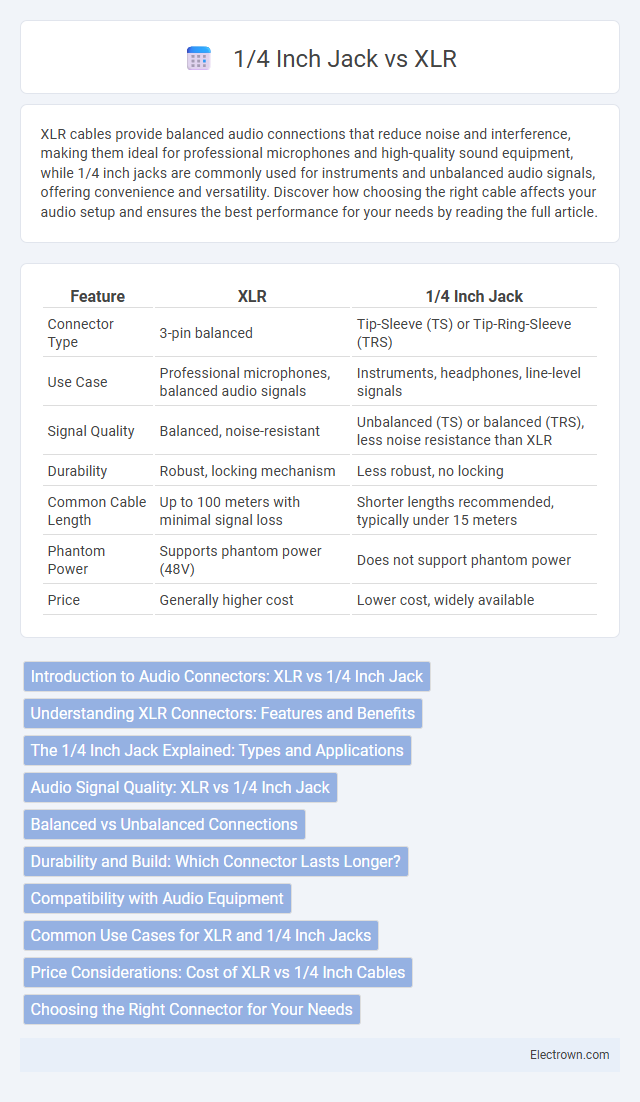XLR cables provide balanced audio connections that reduce noise and interference, making them ideal for professional microphones and high-quality sound equipment, while 1/4 inch jacks are commonly used for instruments and unbalanced audio signals, offering convenience and versatility. Discover how choosing the right cable affects your audio setup and ensures the best performance for your needs by reading the full article.
Table of Comparison
| Feature | XLR | 1/4 Inch Jack |
|---|---|---|
| Connector Type | 3-pin balanced | Tip-Sleeve (TS) or Tip-Ring-Sleeve (TRS) |
| Use Case | Professional microphones, balanced audio signals | Instruments, headphones, line-level signals |
| Signal Quality | Balanced, noise-resistant | Unbalanced (TS) or balanced (TRS), less noise resistance than XLR |
| Durability | Robust, locking mechanism | Less robust, no locking |
| Common Cable Length | Up to 100 meters with minimal signal loss | Shorter lengths recommended, typically under 15 meters |
| Phantom Power | Supports phantom power (48V) | Does not support phantom power |
| Price | Generally higher cost | Lower cost, widely available |
Introduction to Audio Connectors: XLR vs 1/4 Inch Jack
XLR connectors feature three-pin designs delivering balanced audio signals that reduce noise and interference, making them ideal for professional microphones and audio equipment. In contrast, 1/4 inch jacks come in balanced (TRS) and unbalanced (TS) versions, commonly used for instruments and headphones due to their versatility and ease of use. Understanding the signal type, connection durability, and application ensures optimal audio performance when choosing between XLR and 1/4 inch jacks.
Understanding XLR Connectors: Features and Benefits
XLR connectors feature a robust design with three pins that provide balanced audio signals, reducing noise and interference in professional sound setups. Their locking mechanism ensures a secure connection, making them ideal for microphones, mixers, and high-quality audio equipment. Understanding the durability and signal integrity of XLR connectors can help you achieve clear, reliable audio performance in your recordings or live sound systems.
The 1/4 Inch Jack Explained: Types and Applications
The 1/4 inch jack, also known as a TS (Tip-Sleeve) or TRS (Tip-Ring-Sleeve) connector, is widely used for unbalanced mono and balanced stereo audio connections in musical instruments, headphones, and audio equipment. TS jacks are primarily applied for guitar cables and instrument-level signals, while TRS jacks handle balanced audio or stereo signals such as headphones or insert points in mixing consoles. Understanding these types helps you choose the appropriate connection for your audio setup, ensuring optimal signal quality and compatibility.
Audio Signal Quality: XLR vs 1/4 Inch Jack
XLR connectors deliver a balanced audio signal that significantly reduces noise and interference, making them ideal for professional sound environments. In contrast, 1/4 inch jacks, especially unbalanced TS versions, are more susceptible to signal degradation and hum over longer cable runs. Choosing XLR can enhance Your audio signal quality by ensuring clearer, more reliable transmission.
Balanced vs Unbalanced Connections
XLR connectors provide balanced connections that reduce noise and interference, making them ideal for professional audio environments and long cable runs. In contrast, 1/4 inch jacks typically offer unbalanced connections that are more susceptible to signal degradation, especially over extended distances. For your audio setup, choosing XLR ensures clearer sound quality and greater reliability when minimizing unwanted hum or buzz is critical.
Durability and Build: Which Connector Lasts Longer?
XLR connectors feature a robust metal housing and locking mechanism that ensures a secure, long-lasting connection, making them highly durable for professional audio environments. 1/4 inch jacks, while versatile, tend to have a simpler design with plastic or less sturdy metal parts that may wear out faster under frequent use or stress. For your gear, choosing XLR connectors can offer greater longevity and reliability, especially in demanding settings where durability is critical.
Compatibility with Audio Equipment
XLR connectors are widely compatible with professional audio equipment, including microphones, mixers, and high-end audio interfaces, due to their balanced signal transmission that reduces interference. 1/4 inch jacks, commonly found on instruments and consumer audio devices, come in both balanced (TRS) and unbalanced (TS) formats, making them versatile but sometimes less reliable for long cable runs. Your choice depends on the equipment you use and whether you prioritize balanced connectivity for noise reduction or broader compatibility with standard instruments.
Common Use Cases for XLR and 1/4 Inch Jacks
XLR connectors are commonly used in professional audio environments for microphones and balanced audio signals, offering superior noise rejection and secure connections ideal for live performances and studio recordings. 1/4 inch jacks are versatile connectors frequently employed for electric guitars, keyboards, and unbalanced audio equipment, favored in both live sound setups and home studios. The choice between XLR and 1/4 inch jack depends on the need for balanced audio transmission and device compatibility within specific audio applications.
Price Considerations: Cost of XLR vs 1/4 Inch Cables
XLR cables generally cost more than 1/4 inch cables due to their balanced design and superior noise rejection, making them a preferred choice for professional audio applications. While 1/4 inch cables are cheaper and widely used for instruments and casual setups, investing in XLR cables can enhance sound quality and reliability in your recording or live sound environment. Your decision should balance budget constraints with the need for audio clarity and durability.
Choosing the Right Connector for Your Needs
XLR connectors provide balanced audio, reducing noise and interference, making them ideal for professional microphones and long cable runs. 1/4 inch jacks, available in TRS (balanced) and TS (unbalanced) versions, offer versatility for instruments and headphones but may be prone to noise over longer distances. Selecting the right connector depends on the application's need for signal integrity, cable length, and equipment compatibility.
XLR vs 1/4 Inch Jack Infographic

 electrown.com
electrown.com